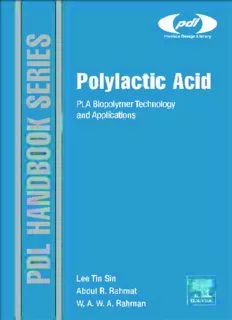Table Of ContentPolylactic Acid
PLASTICSDESIGNLIBRARY(PDL)
PDLHANDBOOKSERIES
SeriesEditor:SinaEbnesajjad,PhD
President,FluoroConsultantsGroup,LLC
ChaddsFord,PA,USA
www.FluoroConsultants.com
ThePDLHandbookSeriesisaimedatawiderangeofengineersandotherprofessionals
workingintheplasticsindustry,andrelatedsectorsusingplasticsandadhesives.
PDLisaseriesofdatabooks,referenceworksandpracticalguidescoveringplastics
engineering,applications,processing,andmanufacturing,andappliedaspectsof
polymerscience,elastomersandadhesives.
Recenttitlesintheseries
Brandau,Bottles,PreformsandClosures,SecondEdition
ISBN:9781437735260
Brandau,StretchBlowMolding,SecondEdition
ISBN:9781437735277
Ebnesajjad,HandbookofAdhesivesandSurfacePreparation
ISBN:9781437744613
Grot,FluorinatedIonomers,SecondEdition
ISBN:9781437744576
Kutz,AppliedPlasticsEngineeringHandbook
ISBN:9781437735147
Kutz,PEEKBiomaterialsHandbook
ISBN:9781437744637
McKeen,PermeabilityPropertiesofPlasticsandElastomers,ThirdEdition
ISBN:9781437734690
Sastri,PlasticsinMedicalDevices
ISBN:9780815520276
Wagner,MultilayerFlexiblePackaging
ISBN:9780815520214
Woishnis&Ebnesajjad,ChemicalResistanceofThermoplastics(2volumeset)
ISBN:9781455778966
Tosubmitanewbookproposalfortheseries,pleasecontact
SinaEbnesajjad,SeriesEditor
[email protected]
or
MatthewDeans,SeniorPublisher
[email protected]
Copyrightr2012ElsevierInc.Allrightsreserved.
Polylactic Acid
PLA Biopolymer Technology and Applications
Lee Tin Sin
Abdul Razak Rahmat
Wan Azian Wan Abdul Rahman
AMSTERDAM(cid:1)BOSTON(cid:1)HEIDELBERG(cid:1)LONDON
NEWYORK(cid:1)OXFORD(cid:1)PARIS(cid:1)SANDIEGO
SANFRANCISCO(cid:1)SINGAPORE(cid:1)SYDNEY(cid:1)TOKYO
WilliamAndrewisanimprintofElsevier
WilliamAndrewisanimprintofElsevier
TheBoulevard,LangfordLane,Kidlington,OxfordOX51GB,UK
225WymanStreet,Waltham,MA02451,USA
Firstedition2012
Copyrightr2012ElsevierInc.Allrightsreserved
Nopartofthispublicationmaybereproduced,storedinaretrievalsystemortransmittedin
anyformorbyanymeanselectronic,mechanical,photocopying,recordingorotherwise
withoutthepriorwrittenpermissionofthepublisher
PermissionsmaybesoughtdirectlyfromElsevier’sScience&TechnologyRights
DepartmentinOxford,UK:phone(144)(0)1865843830;fax(144)(0)1865853333;
email:permissions@elsevier.com.Alternativelyyoucansubmityourrequestonlineby
visitingtheElsevierwebsiteathttp://elsevier.com/locate/permissions,andselecting
ObtainingpermissiontouseElseviermaterial.
Notice
Noresponsibilityisassumedbythepublisherforanyinjuryand/ordamagetopersonsor
propertyasamatterofproductsliability,negligenceorotherwise,orfromanyuseor
operationofanymethods,products,instructionsorideascontainedinthematerialherein.
Becauseofrapidadvancesinthemedicalsciences,inparticular,independentverification
ofdiagnosesanddrugdosagesshouldbemade
BritishLibraryCataloguing-in-PublicationData
AcataloguerecordforthisbookisavailablefromtheBritishLibrary
LibraryofCongressCataloging-in-PublicationData
AcatalogrecordforthisbookisavailablefromtheLibraryofCongress
ISBN:978-1-4377-4459-0
ForinformationonallElsevierpublications
visitourwebsiteatbooks.elsevier.com
TypesetbyMPSLimited,Chennai,India
www.adi-mps.com
PrintedandboundinGreatBritain
1213141516 987654321
Contents
1 Overview of Poly(lactic Acid) 1
1.1 Background to Biodegradable Polymers 1
1.2 Market Potential of Biodegradable Polymers
and PLA 13
1.3 General Properties and Applications of PLA 33
1.3.1 PLA for Domestic Applications 33
1.3.2 PLA and Copolymers for Biomedical
Applications 43
1.4 Environmental Profile of PLA 57
1.5 Ecoprofile of PLA in Mass Production 58
1.6 Environmental Impact of PLA at the
Post-Consumer Stage 63
1.7 Conclusion 67
References 67
2 Synthesis and Production of Poly(lactic Acid) 71
2.1 Introduction 71
2.2 Lactic Acid Production 72
2.2.1 Laboratory Scale Production of Lactic Acid 85
2.3 Lactide and Poly(lactic Acid) Production 86
2.3.1 Review of Lactide Production Technology 88
2.3.2 Polymerization and Copolymerization of
Lactide 94
2.3.3 Lactide Copolymer 97
2.3.4 Quality Control 99
2.3.5 Quantification of Residual Lactide in PLA 100
2.3.6 Quantification of D-Lactic Acid Content
in PLA 103
2.4 Conclusion 105
References 105
v
vi CONTENTS
3 Thermal Properties of Poly(lactic Acid) 109
3.1 Introduction 109
3.2 Thermal Transition and Crystallization of PLA 112
3.3 Thermal Decomposition 123
3.4 Heat Capacity, Thermal Conductivity and
Pressure(cid:3)Volume(cid:3)Temperature of PLA 131
3.5 Conclusion 138
References 139
4 Chemical Properties of Poly(lactic Acid) 143
4.1 Introduction 143
4.2 Stereochemistry of Poly(lactic Acid) 146
4.3 Analytical Technique of PLA 154
4.3.1 Nuclear Magnetic Resonance Spectroscopy 154
4.3.2 Infrared Spectroscopy 157
4.4 Solubility and Barrier Properties of PLA 162
4.4.1 Solubility of Polylactic Acid 163
4.4.2 Permeability of Polylactic Acid 164
4.5 Conclusion 172
References 172
5 Mechanical Properties of Poly(lactic Acid) 177
5.1 Introduction 177
5.2 Effect of Crystallinity and Molecular Weight
on Mechanical Properties of PLA 179
5.3 Effect of Modifier/Plasticizer on PLA 182
5.4 Polymer Blends of PLA 191
5.4.1 Poly(lactic Acid) and Polycaprolactone
Blend 192
5.4.2 Blends of Polylactide with Degradable or
Partially Degradable Polymers 198
5.4.3 Blends of Polylactide and
Polyhydroxyalkanoates 202
5.4.4 PLA Blends with Nondegradable Polymers 207
5.5 Conclusion 215
References 215
CONTENTS vii
6 Rheological Properties of Poly(lactic Acid) 221
6.1 Introduction 221
6.2 Rheological Properties of Poly(lactic Acid) 222
6.3 Effects of Molecular Weight 226
6.4 Effects of Branching 230
6.5 Extensional Viscosity 232
6.6 Solution Viscosity of PLA 233
6.7 Rheological Properties of Polymer Blends 233
6.7.1 PLA/PBAT Blend 235
6.7.2 Blend with Layered Silicate
Nanocomposites 237
6.7.3 PLA/Polystyrene Blend 239
6.8 Conclusion 243
References 243
7 Degradation and Stability of Poly(lactic Acid) 247
7.1 Introduction 247
7.2 Factors Affecting PLA Degradation 248
7.3 Hydrolytic and Enzymatic Degradation of PLA 255
7.4 Environmental Degradation of PLA 265
7.5 Thermal Degradation of PLA 278
7.6 Flame Resistance of PLA 288
7.7 Conclusion 295
References 295
8 Applications of Poly(lactic Acid) 301
8.1 Introduction 301
8.2 Poly(lactic Acid) for Domestic Applications 302
8.3 Poly(lactic Acid) for Engineering and
Agricultural Applications 317
8.4 Poly(lactic Acid) for Biomedical Applications 317
8.5 Conclusion 317
References 326
Index 329
This pageintentionallyleftblank
1 Overview of Poly(lactic Acid)
Chapter Outline
1.1 Background to Biodegradable Polymers 1
1.2 Market Potential of Biodegradable Polymers and PLA 13
1.3 General Properties and Applications of PLA 33
1.3.1 PLA for Domestic Applications 33
1.3.2 PLA and Copolymers for Biomedical
Applications 43
1.4 Environmental Profile of PLA 57
1.5 Ecoprofile of PLA in Mass Production 58
1.6 Environmental Impact of PLA at the Post-Consumer
Stage 63
1.7 Conclusion 67
References 67
1.1 Background to Biodegradable Polymers
People have been using polymers for thousands of years.
In ancient times natural plant gum was used to adhere pieces of
wood in house building. When the ancients started to explore the
oceans, natural plant gum was applied as a waterproof coating to
boats. At that time people did not know the extent to which poly-
mers could be put to use, so their use was limited to very specific
applications. Of course, the ancients depended on plant-derived
polymers. No modifications were made to their formulation, nor
werepolymerssynthesizedtoimproveapplications.
Natural rubber has been known about since 1495, when
Christopher Columbus landed on the island of Haiti and saw
people playing with an elastic ball. At that time rubber latex
was harvested from the rubber tree Hevea brasiliensis as a
sticky lump, which had limited applications. However, by 1844
Charles Goodyear discovered and patented a method to sulfur
PolylacticAcid.DOI:http://dx.doi.org/10.1016/B978-1-4377-4459-0.00001-9
©2012ElsevierInc.Allrightsreserved. 1
Description:Polylactic Acid (PLA) is the first viable thermoplastic that can be produced from a plant-based feedstock such as corn or sugar cane, and yet be processed by the conventional melt processing technologies. At the same time, Polylactic Acid is produced at the largest industrial scale of all biodegrada

